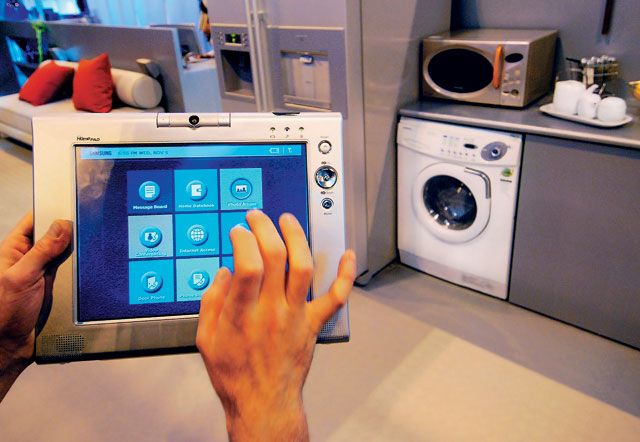Picture the scene — you arrive home from work, hop out of the car to open the garage door, forget to close it again when you've parked and end up walking back to shut it. Then you make it back inside and spend the next ten minutes turning on the air-conditioning, closing curtains and switching lights on. Sounds familiar? It needn't; with the development of ‘smart home' technology, everyday tasks can be done remotely with the help
of a home automation system.
Central control system
According to SmartHome-HDL, a company specialising in home automation systems in the UAE, a home automation system is one where a number of household functions are controlled from a single location. Although many functions around the home are already automated, a fully integrated home automation system brings them all together and combines control into a single multi-functional panel, according to Firas Mazloum, Managing Director of SmartHome-HDL.
Safe and sound
A number of functions can be incorporated into a home automation system, from simple tasks such as drawing curtains to more complex operations such as door access and control of closed circuit television (CCTV) cameras and monitors.
"The system can control safety and security including door access, CCTV cameras and parenting, fire and gas and pool and elevator safety," says Mazloum. The system can also extend its reach to your garden if desired. "[The system can control] irrigation according to weather, wind, rain level and humidity," he says. Some of the more advanced functions of a home automation system include warnings transmitted by the system in case any
part of the property is at risk.
"In case of a storm, the SmartHome weather station will alert the owner on speakers and by SMS to close doors and windows," says Mazloum. “And in case of any water leakage, the system will alert you to avoid flooding."
Customised to your needs
While of course it may be simpler to install a home automation system while a house is under construction, Mazloum says it is also possible to retro-fit a system depending on the type of system chosen and the internal fittings of the home. "There are two available solutions today — one is wired, and the other one is wireless," he says.
Differences between the two systems are mainly found in durability, load handling ability and functionality, but Mazloum says either can be fitted into a house after completion. "Most technology can be installed even in finished homes, including wired technology, provided that the house has false, suspended gypsum or wooden ceilings if [using] the wired selection," he says.
Easy on the pocket
Home automation systems need not break the bank, according to Mazloum. He estimates a system for a typical one-bedroom apartment, including a keyless entry system and options to control lighting and power, air-conditioning, curtains, security and other functions, would cost the homeowner no more than $3,000 (about Dh11,019). “Today's home automation systems are very affordable, depending on the vendor," he says.
In addition, a home automation system can work to save you money by reducing energy output, Mazloum says. "Utilities [such as] lighting are programmed to [switch off] 10 to 15 minutes after the area is left unoccupied, and air conditioning will automatically switch off when the door is left open in any room," he says.
"These are only some examples of programme execution to avoid unnecessary consumption of energy. [You can also have] energy meters and water tank level meters, giving the ultimate monitoring and tracking ability to flatten energy bills." With the system able to monitor other home systems such as pumps, gates, garages and elevators, maintenance costs can also be controlled as alerts will notify you of any required works prior to breakdown.
Your finances may also improve in other ways when a system is installed. "The insurance bill of a fully Smart and secure home is less than that of a normal home, as the client has already invested in systems that will protect, alert and deter," says Mazloum.













